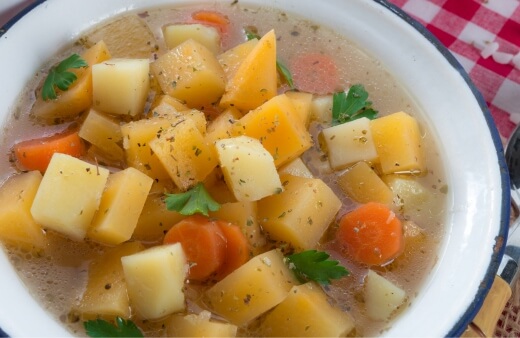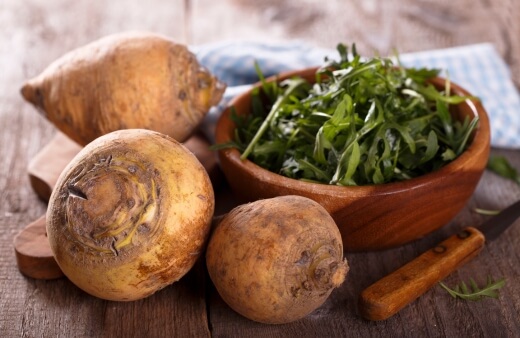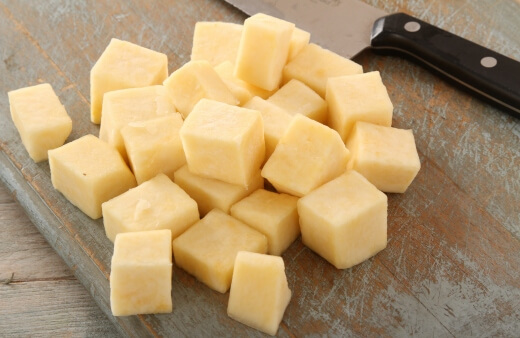Swedes, through no fault of their own, have a reputation as being boring, but these easy-to-grow veggies are far from it, and packed with flavour when harvested properly, and cooked well.
Despite preferring cooler climates, and having a tendency to bolt, they grow happily in Australian gardens, so let us take you on a tour of their growing year.
Starting from seed is always the best bet with brassicas, as they have a fairly long growing season, especially when growing for their root, but you can buy potted seedlings from garden centres and, in most parts of the country, sow them all year round.
More...

Family: | Brassicaceae |
|---|---|
Genus: | Brassica |
Species: | B. napus |
Origin: | Hybrid between common cabbage (B. oleracea) and turnips (B. rapa) |
Common Names: | Rutabaga, Swede, Neep, Swedish turnip |
Location: | Outdoor |
Type: | Root vegetable |
Growth: | Foliage can reach 30cmx30cm |
Sun requirements: | Full sun or part shade |
Foliage Colour: | Green |
Flower Colour: | Yellow, if left to seed |
Flowering: | Spring in their second year |
Fruit: | Edible roots |
Maintenance level: | Low |
Poisonous for pets: | Non-toxic to cats and dogs (can help with digestive problems) |
What are Swedes?

Swedes are a cross between common cabbages and turnips, hence their soft savoy-like flavour, paired with a gorgeously firm texture that cooks and blends well as a base for soups. That places them firmly in the Brassica family, which means they are technically a biennial plant.
However, as with most biennial vegetable plants, they are only really useful as a crop in their first growing season. After that, they flower, go to seed, and make way for new plants, so it’s important to stick to reasonably accurate growing windows, and harvest schedules.
Swedes are, in many parts of the world, called turnips, but turnips are very different vegetables, and much more like a radish in flavour and texture, with a higher water content, and a crisper texture. Turnips are unevenly-round, with pale bases, sometimes with red or greenish caps.
Tip: If you’re struggling to put home-grown produce on the table, the early green leaves sprouting from your turnips make an excellent addition to salads, and can be used as an alternative to other brassicas like kale all year round (just be sure to leave enough foliage for the plant to photosynthesise, and harvest from the base, not the top).
Rutabaga’s Natural Habitat
Swedes are a man made crop, bred from other brassicas - cabbage and turnips. However, it's still possible to work towards recreating the natural habitat of swedes’ parent plants by looking for clues in their own habitat.
Brassica oleracea (wild cabbage) is native to Western Europe and the Mediterranean, while turnips (Brassica rapa) are native to all parts of Asia and Europe. In their native settings these plants, which both have edible roots and leaves, grow best in moist but reasonably well-draining conditions, and prefer to grow in bright sunny spots.
In Australia, our weather conditions are generally harsher, with longer summers, so these biennial plants can bolt in very hot summers, leading to a lot of foliage and flowers but very little edible root.
It’s not too hot where I am, so I don’t usually have problems with bolting, but in hotter parts of the country, it’s worth providing some protection and shade with horticultural fleece to bring temperatures down slightly.
Growing Swedes in Australia
Swedes are best grown from seed. Partly because it's cheaper, and partly because they’re just incredibly easy to grow. Buying seedlings is an option, but as they can be directly sowed from winter through to autumn outdoors, there’s honestly not much point.

When to Sow Swedes
Swedes are best sown from late summer or early autumn, into winter. Avoid the temptation to succession sow though as, like many brassicas, once they mature, they are perfectly happy to be left in the ground for a few weeks, or even months in cooler conditions.
Sowing Swedes Indoors
If you’ve got AC at home, you can get a head start on swede sowing by sowing indoors on a bright windowsill in mid-summer, providing the temperatures are a few degrees lower than outdoors.


Get Your Free Guide:
Master Growing Australian Natives eBook
A Must Have Complete Guide for Every Australian Garden
Get Your Free Guide:
Master Growing Australian Natives eBook
A Must Have Complete Guide for Every Australian Garden
For busy gardens with crop rotation through the year in each bed, sowing indoors will also help you make sure there are always plants ready to plug in as soon as your last crop is finished.
Where to Sow Swedes
Sow swedes in trays or seed compost, or directly where they are to grow in prepared beds outdoors. Sow swedes at a depth of 10-20mm, and cover with good compost. Like all brassicas, they are hungry feeders and will grow best with properly fed soil.
Outdoor sown swedes should be spaced about 10cm apart and thinned to 20-30cm apart when they germinate to allow space for the roots to develop without competition.
Light & Temperature
Swedes like bright light, but should be kept out of direct midday sun if possible. That might mean placing your bed in the shade of a tree or making use of east or west-facing fences.
Personally, I find it most useful to grow a row of tall peas (try Alderman/Tall Telephone Peas) up a trellis on the North facing side of swede beds to provide dappled shade.
Soil & Drainage
While brassicas are never truly fussy about their soil conditions, it is worth noting that they are one of the few vegetables that don’t like acid soils. They prefer neutral, or even slightly alkaline soil. If you’ve got slightly acidic conditions, add a few handfuls of lime to the soil to shift the pH in the right direction.
In terms of drainage, they like moisture, but should never be sat in damp beds. If you have clay soil, grow swedes in pots or raised beds to avoid the problem altogether. On sandy soil, mix in plenty of organic compost to boost nutrition and moisture retention.
Planting Swedes
For swedes sown indoors, or seedlings bought from the garden centre, their growing conditions are identical to those grown from seed, but they should be spaced out at least 30cm apart.
It’s also ok to bury their stems slightly to provide leggy seedlings with a bit more support and to encourage deeper rooting, which can prevent the tops from showing too much above the soil (the best part of a swede is the paler part that hasn’t been exposed to light.
The darker section is generally more watery and has a tougher skin, but is still perfectly edible.
Caring for Rutabaga
As with most brassicas, they can be incredibly low maintenance, or incredibly high maintenance depending on the weather and your garden soil. On poor soil, swedes will need feeding every few weeks but, on good soil, a single feed or mulch before planting will be more than enough for the year.

What Fertiliser to Use
The one standard method of feeding swedes is simple and should, ideally, be done before sowing. Rake over any compacted soil and, if nutrient-low, enrich with a few inches of good compost.
Then sprinkle over one handful of general fertiliser (fish, blood, and bone is the most widely used for brassicas) per square metre. On very poor soil, or for swedes sown into the soil without enrichment, feed them with a general vegetable feed every two weeks.
I use liquid seaweed, but any organic vegetable feed will do, mixed in with water at a ratio of 1 capful per 6 gallons.
Watering Swedes
Water swedes through dry weather, and hot summers. Hot summers can trigger these biennial veggies to bolt early and set seed in their first year, which will result in small and woody roots.
In droughts, soak the beds once a week, or whenever it is dry, but avoid wetting the leaves at all costs, and mildew and rust can spread easily between beds when brassicas have wet foliage.
Harvesting and Storing Swedes
If you’re new to root veg, the signs that your crops are ready to harvest are perhaps a touch less intuitive than most gardeners appreciate, but when you get used to it, swedes do give you some simple signs that they’re ready for harvest.
When are Swedes Ready for Harvest?
Swedes might be a root vegetable, but when they’re ready to harvest their roots will begin to protrude from the soil around the base of the stem. You also won’t harm your swede by tickling around at the base of the plant to feel the size of the root.
Another clue is that the top growth will significantly slow down, and begin to fade at the end of its growing season.

Harvesting Swedes
You can harvest youngish swedes for a strong brassica flavour, but it’s best (if possible) to leave them in the ground until they are touched by frost, which helps to sweeten their flesh.
Because swedes are visible above ground, they are simple to harvest. Just dig in with a garden fork a few inches away from the visible root and pry it out of the soil. Don’t worry if they’re slightly misshapen, that tends to be the case with most swedes grown in normal conditions.
How to Store Swedes
Swedes can be stored fresh in the ground right through winter, but there is a risk of pest problems like maggots as a result. In the fridge, or even in a cool dark cupboard, swedes can last for several weeks before use.
But by far the best way to store swede long term is to freeze them. Simply chop them into chunks and toss them into an airtight bag in the freezer. You can blanch them to speed up cooking times and retain a good cooked texture too.
Common Swede Problems
As brassicas, swedes are not without their pest problems, but the vast majority of swede pests affect the top growth, and will not harm the root. Diseases are a little more complex, with club roots being a big problem for all brassicas, especially root brassicas like swede.
Swede pests
When swedes start growing strongly, they are quite likely to attract aphids, blackfly, or cabbage white butterflies. There are dozens of other moths and butterflies that will lay eggs on the underside of brassica leaves too.
The simplest way to prevent this is by netting the bed so flying insects can’t get access, but garlic sprays have been proven to be quite effective at masking their smell and reducing pests.
Slugs and beetles are the worst offenders when it comes to leaf eating, and spreading rust or mildews. We use lightly crushed eggshells to deter slugs and distract them by growing a border of marigolds around any brassica bed.
Swede diseases
Downy mildew, dry rot, and club root are the worst diseases affecting swedes in Australia. Club root, if found in your soil, can destroy entire crops, and will survive on uncultivated earth for up to six years. The only way to prevent it is to stop growing brassicas.
Downy mildew is largely a result of wetting foliage in humid conditions. Try to keep foliage dry to avoid this simple problem, but also don’t be disheartened. Simply removing affected leaves and treating them with organic fungicides will often be enough to get your swede through to harvest time as it doesn’t affect the root.
Dry rot is, as it sounds, similar to root rot, but rather than being caused by damp conditions is caused by a fungal pathogen called Leptosphaeria maculans, which can spread in most conditions.
Like club root, you should avoid planting any brassicas in the same patch for several years to stop it from spreading.
Frequently Asked Questions About Swedes

Are swedes easy to grow?
Swedes are easy to grow, and with a little bit of preparation give you plentiful harvests from very little ongoing effort. Simply prepare your soil with a dry fertiliser or plenty of compost, and sow.
In good rainy springs, you can expect harvests with next to no input after sowing.
How long does it take swedes to grow?
Swedes take about six months to grow from seed to harvest, but leaving them in the soil until they are touched by frost will help to improve their flavour.
What is the best fertiliser for swedes?
The best fertiliser for swedes is any general-purpose fertiliser. We use fish blood and bone, but any granular dry feed or even chicken manure will provide most of the nutrients they need.
Alternatively, rotted manure or compost can be used to enrich beds, or liquid feeds can be applied every 2-3 weeks after germination.
Are swedes winter hardy?
Swedes are winter hardy in almost all conditions, and frost actually helps to improve their flavour after a long growing season.
How much does swede yield?
Swedes are high-yielding crops, producing roots averaging up to 1kg in weight, but sometimes more.
Why does my swede taste bitter?
Growing in very dry conditions can cause swedes to develop a bitter flavour. This can happen if they are allowed to dry out at any stage in the growing cycle, but will usually mellow after frost. Try to keep their oil reasonably moist right through the growing year.
How often should I water my swedes?
Water swedes whenever the soil is dry to touch at the surface. They need plenty of moisture to develop healthy foliage as well as to swell their roots.
Can I eat swedes raw?
Swedes are actually quite delicious when finely sliced and served raw in salads. Depending on their growing conditions they can have a beautifully peppery flavour which works well with their base brassica flavour.
Wrapping Up Our Swedes Growing Guide
Swedes are simple to grow, and an easy way to provide you with over-wintering harvests to keep you fed through the more challenging months in the garden.
Whether you’re building a comprehensive garden or rotational crops or simply want to try your hand at growing something new, give swedes a go. They have much better flavour, and are far more versatile in the kitchen than their reputation suggests.
Published on April 4, 2023 by Maisie Blevins
Last Updated on February 23, 2024




